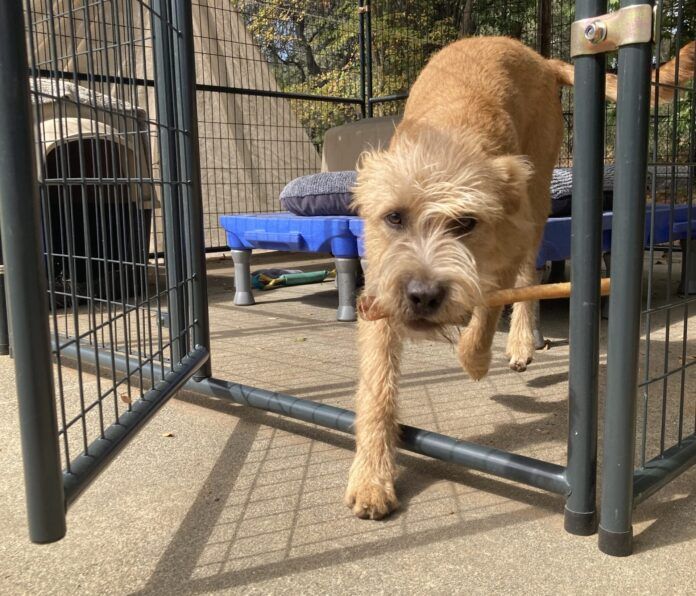
The other day the New York Times published an excerpt from canine behavioral researcher and author Alexandra Horowitz’s newest and most excellent book, The Year of the Puppy: How Dogs Become Themselves, (Viking, 2022). The excerpt was about canine adolescence, a period of a dog’s life that Horowitz calls “woefully understudied by researchers and often completely ignored by dog people.” I was thrilled to read this, because often, owners are unprepared for this phase and shocked by the changing moods and needs of their new dog.
Perhaps because of the greater emphasis on the changing nutritional needs of a growing and then adult dog, it seems like the whole world divides the stages in dog lives into two, and perhaps three major categories, each with specific challenges. There’s puppyhood, when we are carefully managing the puppy’s diet (so as to provide him with precise nutrition for a just-right rate of growth, neither too fast nor too slow), as well as managing the puppy’s environment and setting behavioral expectations. Usually, folks then skip right to adulthood, when dogs are frequently switched to “adult maintenance” diets and expected to have achieved a certain standard of civilized behavior. Sometimes, the nutritional and medical needs of the senior dog are also given separate consideration.
But few people talk about the phase of a dog’s life that humans find the most challenging and frustrating: the “teenager” phase, when the behaviors that our adorable puppies have been performing on cue for months suddenly seem to be missing from our adolescent dogs’ memory; when the dog who, since adoption, has cheerfully greeted humans of every size, shape, and color begins barking, growling, or even lunging at strangers; and when so-called “nuisance” behaviors like escaping confinement, barking, fence-fighting, and chewing furniture start emerging.
It’s no coincidence that more dogs are surrendered to shelters at this phase of a dog’s life than any other. People who were prepared for this phase sometimes find themselves wondering if they made a big mistake in adopting; people who spontaneously brought a puppy home without preparation often bail on their responsibility for the dog’s well-being at this time. The dog is no longer cute and easy; without good management and training, he can seriously disrupt people’s lives, even cost them a marriage or housing!
My foster-fail puppy Boone is right there: 9 months old, gangly as all-get out – and no longer the pudgy puppy who was content in confinement as long as he had something to chew on. Now he knows there is a whole world of action and fun he’s missing out on when he’s been left in my office or the outdoor dog pen while I go on a bike ride, and he objects! If he sees so much as my bike helmet come out of the closet before I’ve put him in temporary safe custody, he’s learned to be wary of being lured into said enclosures. Or rather, he’ll go, while looking for the fresh bone I took out of the freezer that I generally lock him up with – but he’s not past trying to dash out the door with the bone if I’m inattentive while leaving the enclosure myself. That’s not a witless puppy’s move, nor a responsible adult dog tactic; that’s a teenager’s ill-advised stratagem!

Fortunately, WDJ has plenty of articles we’ve published in the past about this fraught phase of a dog’s life – or, I should say, the fraught phase in the dog/human relationship (dogs probably don’t perceive the phase as a problem; it’s their owners that do). I’ve been reviewing them myself, and they are extremely informative. If you have a dog in the adolescent phase – approximately, between about 6 months and 2 years old – you might want to read some of these helpful and encouraging articles. If you can continue to guide your dog through this developmental phase with patience, humor, and understanding, you’ll end up with the best dog ever. I know, because I’ve done it at least twice so far, and I couldn’t love the results any more.
Read more on adolescent dogs:
https://www.whole-dog-journal.com/training/angst-with-your-adolescent-dog/
https://www.whole-dog-journal.com/blog/teenage-dogs-can-be-difficult/ (This article contains a half-dozen links to even more WDJ articles on adolescence.)






This is a great article and spot on! Again where I have raised many fabulous dogs and knowing how frustrating it can be at what I call the teenage years. I am right now with a puppy at 15 weeks old that is very mature for his age that I swear is already in his teenage years. Acting out just as though he were an older pup! I must say this boy from the time I brought him home was different from all my other dogs. He potty trained instinctively and was asking to go out on day two. I never had one accident in my house. This pup had no fear of anything and was going up and down stairs without my encouragement. Which with all other dogs I had to train on stairs. He uses my bar stools as obstacle coarse to navigate in and out and up and down through the pedestals. I am talking about a Great Dane puppy with this ability. As I am writing this he just came up to me after having the zoomies touching my finger showing me his happiness in play. So yes all dogs have the good days and the bad days. It takes patience and love. A kind heart and understanding of the 2 years or 3 depending on the breed of dog you decided on. I have posted so many tines about this very subject please think before buying that cute puppy because they do not stay cute forever. Make a commitment to that precious animal for life or not at all.
Dear Nancy, I normally follow Otto’s senior aging process closely, because I too, have a 15 year old (Cairn) Terrier with very same issues. I just love to see the Foster failure 😂 Boone, and I am so happy to see that Otto got a Terrier apprentice- although I. Sure he is mostly annoyed by the “teenager” Boone behavior- as my senior Terrier would be. Congrats on this little guy, may he bring lots of sunshine and mischief into your life
I have a question about how older dogs (4 – 5+) react to dogs in their teenage years. My 6 yr old Aussie plays with every and any dog – always enticing other dogs to play or chase or just have fun. He is also very good with young puppies, letting them chew or climb on him. It’s different when we encounter an adolescent dog – mostly between 14 – 20 months – then he turns into a grumpy old guy. He snarls and tells them off, and then leaves them. Most of the time the adolescent turns right around and goes to play with him again. And gets another dose of grumpy adult. Apparently what he does is not scary enough to chase them off.
Any idea what’s going on? I don’t particularly see the adolescent dog doing inappropriate dog interactions. It’s gotten so I can tell if it’s an adolescent dog by my dog’s reaction.
First of all I love the picture of your 3 dogs sitting in a semi-circle and looking at you. I mostly have had lots of “used” elderly dogs in my life but I did adopt one Golden Retriever puppy from the GR rescue group that I belonged to. One of the foster dogs had 11 puppies……and because I had been a good adopter and volunteer I had first choice of a puppy. I chose a beautiful and large female that I named Chloe. She was a beautiful and spirited puppy……she chewed a knob on my brand new dining room cabinet within 5 minutes of being in the house (I kept the chewed knob on the drawer knowing that someday she would be gone & I wanted to remember her). At 9 months she was a healthy 75 pounds…..and a teenager! Her energy level was amazing……I had a large fenced in yard and an inground pool….and I had other dogs for play mates…..and my second job was keeping her exercised and trained. At 2 years of age she developed into a loyal and loving companion…….and I miss her every day. It was worth every minute of effort to love and guide her through her teen age year.
When are you going to accept Apple Pay? I know Facebook doesn’t like it, but it’s convenient, so I like it … for now!
Love the picture of your 3 pups!!!